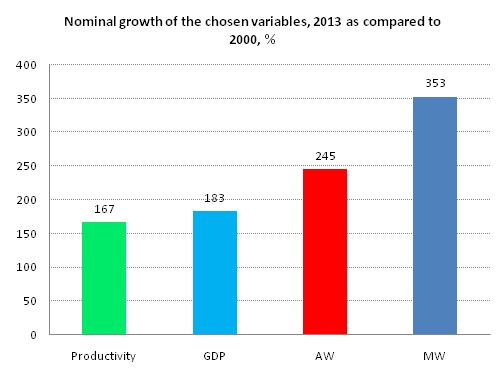New Research by IME: How Does the Growth of the Minimum Wage Impact on Employment in Bulgaria?

New Research by IME: How does the growth of the minimum wage impact on employment in Bulgaria?
Every time the minimum wage grows by 100 levs, 24.5 thousand jobs are lost among the least educated
For years the impact of the minimum wage (MW) on employment has been a subject of academic interest and a central topic in a number of research papers. In Bulgaria however, no empirical research, analyzing the impact that the dynamics of the minimum wage has on employment in the country, has been published to date. At the same time, the minimum wage has been rising rapidly in the past several years, increasing from 75 levs to 310 levs between 2000 and 2013. This rise has been seriously outstripping the growth of average wages (AW), GDP, and labor productivity. The differences between wages in Bulgaria’s different regions are also significant which implies different potential effects from minimum wage hikes in different parts of the country.

Source: NSI, Council of Ministers’ decrees
In 2014 and 2015 the minimum wage continued to grow at a fast pace (up to 340 levs in 2014, 360 lv. effective January 1, 2015 and 380 lv. from July 1, 2015 onward), and the government’s medium-term plan is for it to reach 420 lv. in early 2016 and 450 lv. in 2017. Considering the quick rise of the minimum wage, it is extremely important to research the potential effect of this policy on employment, especially amongst the most vulnerable groups on the labor market.
IME’s staff has set the goal to fill the void of empirical research in this area by analysing the potential effects of minimum wage hikes on employment among the least qualified workers, i.e. those with primary or lower education. For that purpose, an econometric model was constructed, integrating and testing data for the 28 Bulgarian districts, spanning between the years 2003 and 2013.
The analysis conducted in this paper provides clear and concrete econometric evidence in support of the hypothesis that the rise of the minimum wage has an adverse effect on employment amongst the least-educated workforce in Bulgaria. Every time the minimum wage increases by 100 levs, the rate of employment amongst those with primary or lower education declines by an average of 1,4%. Measured against the size of the labor force in 2013, this means a loss of 24 520 jobs. Given that the coefficient of employment is traditionally very low in this segment of the labor market – varying between 9% and 26% in the different districts in 2013, such a reduction in employment in response to a hike of the minimum wage should not be underestimated. This means that for every 100 lv. increase of the minimum wage, employment rates among the least qualified decline by 5% to 16% depending on the area.
IME’s investigation into the matter covers a relatively long period of 11 years in all regions of Bulgaria and aims to fill in the gap of (publicly available) research, dealing with the impact of minimum wage hikes on employment. The econometric evidence underpins long-lasting concerns, shared by both local and foreign economists, that increases of the minimum wage adversely affect employment amongst the least-qualified workers. Considering the results of the analysis, it is not so suprising that employment rates among the least skilled in Bulgaria are at such low levels and cannot even reach 10% in some of the less-developed areas.
On the basis of the presented econometric model, we can predict the numerical effect that the planned hike of the minimum wage to 450 lv. in 2017 will have on employment amongst the least-educated. If the minimum wage rises from 340 lv. in 2013 (the last year of the analysed period) to 450 lv. in 2017, we can expect the employment rate among those with primary and lower education to decline by 1,54 percentage points. So, if the employment rate for people aged between 15 and 64 years and having primary or lower education was 17,5% in 2013, the planned hike of the legally binding minimum wage can lead to a decline in the employment rate of this group below 16% in 2017 (all else being equal). If we assume that the size of the workforce with primary or lower education remains the same between 2013 and 2017, this decline in employment means a loss of 26 272 jobs.
These adverse effects on employment must be taken into consideration by society and the government every time a potential minimum wage increase is being considered. Because not all of these who work for a minimum wage pay will enjoy greater incomes at the new, higher level – tens of thousands will simply lose their jobs. The decision whether minimum wages should be raised or not in effect needs to be a conscious choice for a simultaneous reduction of employment among the low-skilled workers.
With this analysis in mind, IME recommends a freeze in the level of the minimum wage in the future with the goal of preventing further loss of jobs for one of the most vulnerable groups on the labor market – the people with primary or lower education. Otherwise, the rate of employment for this group will reach critically low levels, while unemployment and economic inactivity will continue to expand.
The whole analysis (in Bulgarian) can be read here.


